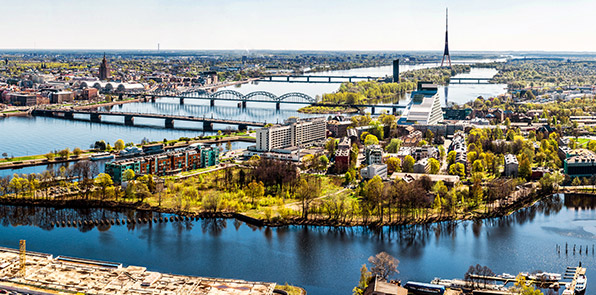City Break in Riga
The biggest holiday city in the Baltics, Riga has a reputation both good and bad. The good side, they say, is very good and the bad, well it can get pretty grim.
On the plus side Riga has a beautiful city centre, full of cobbled courtyards and turn-of-the-century vistas that will take your breath away.
Its streets boast some of the best examples of Art Nouveau in Europe and Riga has a cafe society to match, making it an attractive cheap flight holiday destination. Before you fly out check out and compare a wide range of hotels in Riga.
On the downside is a raucous night life often marred by yobbo stag party Brits whose idea of a good holiday night out is to urinate freely on national monuments.
Riga, of course, is no stranger to late night revellers. It was once the holiday playground for the Russian military, and Communist colonels headed here regularly to taste its sizzling night life.
Since the break with Communism, Riga has gained in reputation as a fun-filled, fast-forward holiday city, especially in the air travel market, and the locals seem keen to re-establish its pre-war eminence as the 'Paris of the Baltics'.
However, the rise in booze fuelled Riga stag weekends has earned it a 'Bangkok of the Baltics' tag, with a city centre nightlife mostly given over to lap dancing and strip clubs.
Latvia's economy, so long in the Soviet doldrums, is now booming and holiday breaks are big business. Fortunately, the city values its past as much as it welcomes the future. Old buildings aren't being ripped down for modern concrete towers (except for a few Stalinist monstrosities) and the centre is now a World Heritage Site.
This is a rising star in the city break holidays market and one of Europe's most exciting weekend break destinations. It's a pity that those now flying in on Riga air travel stag party holiday booze-ups are nowhere near as charming as their hosts.

Hotels near Riga
You are looking for a hotel in Riga or in Latvia for tourist or professional purposes? Please check our selection of hotels and lodgings in Riga.
Beach resorts in Riga
Riga has many visitor attractions, the principal ones being the medieval city centre itself with its cobbled courtyards and narrow streets; the 13th century Dome Cathedral, the largest church in the Baltic; St Peter's Church with a 123m high tower; and the Latvian Museum of Occupation which documents the recent history of both Riga and Latvia.
There are several major tourist attractions in the area around Riga, including a string of seaside beach resorts known collectively as Jurmala.
There is a the extensive Guaja National Park with a well maintained network of nature trails and adventure sports, and Rundale Palace and museum which houses outstanding examples of rococo and baroque art and artifacts and has notable formal gardens.
Riga has a relatively new airport about 8km from the city centre and also has good road and rail connections, though rail lines connect mainly with countries to the east. There is also a ferry port with regular services to Germany, Sweden and Finland. The city has an extensive tram and bus network.
Vibrant nightlife in Riga
Today Riga has a population of about 815,000, making it the largest city in the Baltic states although recent migration has seen the population on the decline since 1990. The population is mainly split between Latvians and Russians at about 40% each.
Tourism has grown substantially with the rise of cheap flight airlines. Once a favourite holiday destination for Russians, Riga now has a reputation for its vibrant nightlife and the city attracts many young visitors each year to its many bars and clubs.
It is a major destination for stag party outings from Britain and this has brought problems of drunken behaviour by gangs of young men in city centre streets as well as a major growth in lap dancing and sex clubs.

